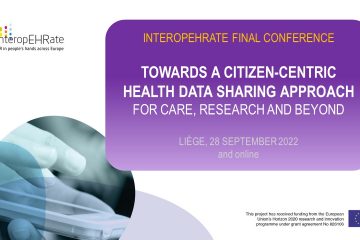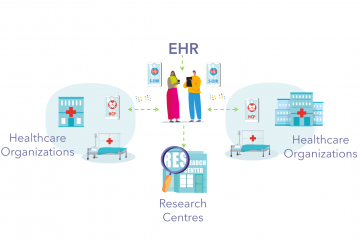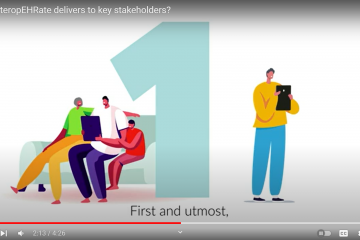FHIR-based protocols to support a citizen-centric approach
InteropEHRate solutions draw on a citizen-centric approach to overcome the caveats posed by the healthcare-centred model. Through their mobile devices, citizens are in control of their personal health data and able to share it with healthcare professionals and research centres.
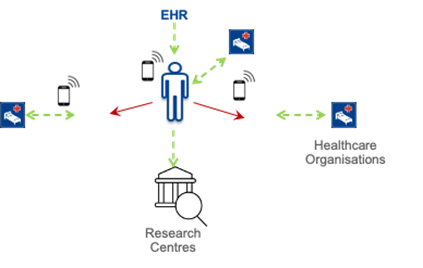
Smart Electronic Health Record (S-EHR) are mobile applications that store health data in smartphones, independent from cloud storage. InteropEHRate open protocols enable S-EHR to securely exchange health data under citizens’ control of what to share, with whom and when. They are thus a key vehicle for the citizen-centric model.
This new approach allows citizens and healthcare providers to access data also offline with high privacy and control, rendering patients more health aware. Researchers can obtain combined clinical and wellness data more easily.
InteropEHRate ambitions thus to actively contribute to the next concrete steps following the February 2019 recommendation European Electronic Health Record exchange format.
What is InteropEHRate concretely developing?
InteropEHRate develops open-source communication protocols and a conformance model defined by a set of constraints for mobile applications and cloud services, and a reference implementation. Health data can be exchanged without internet and cloud storage, making it thus possible to avoid exposing personal health information to cloud providers. The protocols can thus be used to share personal health data with any defined organisation for a well-defined purpose and in an entirely secured environment. The protocols are also very appropriate to support secure cross-border exchange of health data as they include translation resources thanks to the adoption and mapping of common International terminologies. This aspect of the IEHR health tools will be detailed in a future article.
Device-to-Device (D2D), Remote-to-Device (R2D) and Research Data Sharing (RDS) open protocols structure thus data according to specific profiles, ensuring a common interpretation of health data and a trustful translation in different languages. Protocols are based on HL7 Fast Healthcare Interoperability Resources (FHIR)[1] standard and exploit the eIDAS network[2] for cross-border digital authentication of European Citizens.
InteropEHRate open specifications bring specific advantages. Citizens and health organizations are redeemed from vendor locking and data provenance is digitally traced. Citizens can log in with the same account in different EU states through eIDAS and may receive a digital copy of health data produced in other countries. Common FHIR profiles support reliable translation in different natural languages.
InteropEHRate open protocols
Device-to-Device (D2D): Secure IT communication protocol and remote APIs for exchanging health data between two nearby devices without an internet connection, through the Bluetooth protocol, one running an S-EHR App and the other running an HCP App.
R2D Access: Secure IT communication protocol and remote API used by an S-EHR App for receiving health data from a healthcare organisation via the internet.
R2D Backup: Secure IT communication protocol and remote API for the backup of health data from an S-EHR App on an S-EHR Cloud.
R2D Emergency: Secure IT communication protocol (and remote API) for the exchange of health data between an HCP App and an S-EHR Cloud during emergency care.
Research Data Sharing (RDS): Secure IT communication protocol (and APIs) for publishing and retrieving machine-processable descriptions of research studies and for sending citizen’s consents and health data from S-EHR Apps to research centres, without any cloud storage of health data.
The project is also developing the InteropEHRate Framework, a reference implementation of the open specifications that will be piloted with patients in four hospitals. The open specifications, libraries are reference implementation guideline are published on the project website.
To support different use scenarios, these protocols can be exploited independently or in synergy. Software providers may deploy different implementations of the protocols, applications and services defined by the InteropEHRate open specification. Conformance to the open specifications guarantee the interoperability among implementations of different vendors.
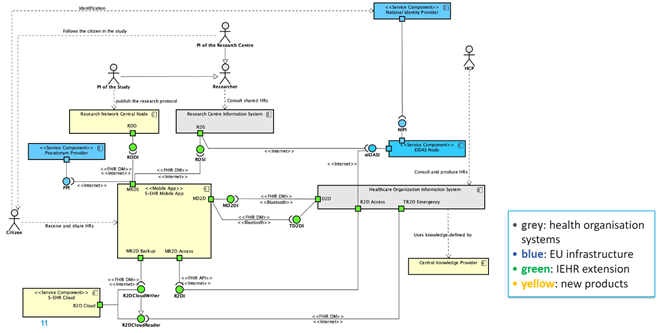
As figure 2 shows, the IEHR protocols make use of the EU infrastructure but also provides the industry (and in particular the SMEs sector) with very promising development possibilities as they can be easily embedded in multiple new innovative products.
[1] FHIR is a standard developed by HL7 in response to the growing use of electronic health records (EHRs) and aims to “simplify implementation without sacrificing information integrity.” To do this, FHIR “leverages existing logical and theoretical models to provide a consistent, easy to implement, and rigorous mechanism for exchanging data between healthcare applications.
[2] eID is a set of services provided by the European Commission to enable the mutual recognition of national electronic identification schemes (eID) across borders. It allows European citizens to use their national eIDs when accessing online services from other European countries.
